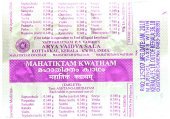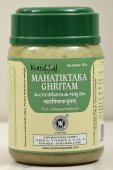Parpataka, Parpaṭaka: 11 definitions
Introduction:
Parpataka means something in Hinduism, Sanskrit, biology. If you want to know the exact meaning, history, etymology or English translation of this term then check out the descriptions on this page. Add your comment or reference to a book if you want to contribute to this summary article.
In Hinduism
Ayurveda (science of life)
Kalpa (Formulas, Drug prescriptions and other Medicinal preparations)
Source: Ancient Science of Life: Yogaśataka of Pandita VararuciParpaṭaka (पर्पटक) refers to a medicinal plant known as Fumaria indica Hausskn., and is mentioned in the 10th century Yogaśataka written by Pandita Vararuci.—The Yogaśataka of Pandita Vararuci is an example of this category. This book attracts reader by its very easy language and formulations which can be easily prepared and have small number of herbs (viz., Parpaṭaka). It describes only those formulations which are the most common and can be used in majority conditions of diseases.
Cikitsa (natural therapy and treatment for medical conditions)
Source: Ancient Science of Life: Botanical identification of plants described in Mādhava CikitsāParpaṭaka (पर्पटक) refers to the medicinal plant Fumaria parviflora Lamk. Syn. Fumaria indica Pugsley, and is used in the treatment of atisāra (diarrhoea), according to the 7th century Mādhavacikitsā chapter 2. Atisāra refers to a condition where there are three or more loose or liquid stools (bowel movements) per day or more stool than normal. The second chapter of the Mādhavacikitsā explains several preparations [including Parpaṭaka] through 60 Sanskrit verses about treating this problem.
The plant Fumaria parviflora Lamk. Syn. Fumaria indica Pugsley (Parpaṭaka) is also known as Parpaṭa according to both the Ayurvedic Formulary and the Ayurvedic Pharmacopoeia of India.
Nighantu (Synonyms and Characteristics of Drugs and technical terms)
Source: WorldCat: Rāj nighaṇṭuParpaṭaka (पर्पटक) is another name for Parpaṭa, a medicinal plant identified with various varieties and species, according to verse 5.8-10 of the 13th-century Raj Nighantu or Rājanighaṇṭu. The fifth chapter (parpaṭādi-varga) of this book enumerates sixty varieties of smaller plants (kṣudra-kṣupa). Together with the names Parpaṭaka and Parpaṭa, there are a total of eighteen Sanskrit synonyms identified for this plant.
Unclassified Ayurveda definitions
Source: Wisdom Library: Āyurveda and botany1) Parpaṭaka (पर्पट) is a Sanskrit word [probably] referring to Hedyotis corymbosa, from the Rubiaceae family. Certain plant parts of Parpaṭaka are eaten as a vegetable (śāka), according to Caraka in his Carakasaṃhitā sūtrasthāna (chapter 27), a classical Ayurvedic work. The plant is therefore part of the Śākavarga group of medicinal plants, referring to the “group of vegetables/pot-herbs”.
2) Parpaṭaka (पर्पटक) is a Sanskrit word referring to Rangia repens (trailing rungia), a species of plant from the Acanthaceae (acanthus). It is also known as Parpaṭa. It is used throughout Ayurvedic literature such as the Caraka-saṃhitā and the Suśruta-saṃhitā. Other commonly used English names include “creeping rungia”. It is an annual herb, growing 10-30 cm tall. It is commonly found in the grasslands in the Western Ghats. Flowering: November.

Āyurveda (आयुर्वेद, ayurveda) is a branch of Indian science dealing with medicine, herbalism, taxology, anatomy, surgery, alchemy and related topics. Traditional practice of Āyurveda in ancient India dates back to at least the first millenium BC. Literature is commonly written in Sanskrit using various poetic metres.
Biology (plants and animals)
Source: Wisdom Library: Local Names of Plants and DrugsParpataka [ಪರ್ಪಾಟಕ] in the Kannada language is the name of a plant identified with Trigastrotheca pentaphylla (L.) Thulin from the Molluginaceae (Carpetweed) family having the following synonyms: Mollugo pentaphylla. For the possible medicinal usage of parpataka, you can check this page for potential sources and references, although be aware that any some or none of the side-effects may not be mentioned here, wether they be harmful or beneficial to health.
Parpataka [पर्पटक] in the Sanskrit language, ibid. previous identification.
Parpataka in the Kannada language is the name of a plant identified with Glossocardia bosvallia from the Asteraceae (Sunflower) family having the following synonyms: Verbesina bosvallia.
Parpataka in the Kannada language, ibid. previous identification.
Parpataka in the Nepali language is the name of a plant identified with Hypertelis cerviana (L.) Thulin from the Molluginaceae (Carpetweed) family having the following synonyms: Mollugo cerviana, Pharnaceum cerviana, Pharnaceum glabrum.
Parpataka in the Sanskrit language, ibid. previous identification.
Source: Google Books: CRC World Dictionary (Regional names)1) Parpataka in India is the name of a plant defined with Mollugo cerviana in various botanical sources. This page contains potential references in Ayurveda, modern medicine, and other folk traditions or local practices It has the synonym Pharnaceum cervianum L. (among others).
2) Parpataka is also identified with Oldenlandia corymbosa It has the synonym Gerontogea biflora (Lam.) Cham. & Schltdl. (etc.).
3) Parpataka is also identified with Oldenlandia herbacea It has the synonym Hedyotis linearis Steud. (etc.).
Example references for further research on medicinal uses or toxicity (see latin names for full list):
· Hortus Bengalensis (1814)
· Prodromus Systematis Naturalis Regni Vegetabilis (1830)
· Monographs in Systematic Botany from the Missouri Botanical Garden (1999)
· Prodr. Flora Indica, or ‘Descriptions of Indian Plants’ Orient. (1834)
· Prop. Brit. Bot. (1929)
· Plantarum Minus Cognitarum Pugillus (1815)
If you are looking for specific details regarding Parpataka, for example health benefits, side effects, extract dosage, pregnancy safety, chemical composition, diet and recipes, have a look at these references.

This sections includes definitions from the five kingdoms of living things: Animals, Plants, Fungi, Protists and Monera. It will include both the official binomial nomenclature (scientific names usually in Latin) as well as regional spellings and variants.
Languages of India and abroad
Sanskrit dictionary
Source: Cologne Digital Sanskrit Dictionaries: Edgerton Buddhist Hybrid Sanskrit DictionaryParpaṭaka (पर्पटक).—(-parpaṭaka), m. (= Sanskrit °ṭa, a kind of cake; AMg. pappaḍa, a thin paper-like dried cake, [Ardha-Māgadhī Dictionary]; in Pali only recorded in bhūmi-pappaṭaka), noted only in bhū-, bhūmi-, pṛthivī-p°, qq.v., all of which (certainly the first two) seem clearly to mean a kind of edible mushroom (like Pali bhūmi-p°, above); lit. earth-(pan)cake or the like.
Source: Cologne Digital Sanskrit Dictionaries: Monier-Williams Sanskrit-English DictionaryParpaṭaka (पर्पटक):—[from parp] m. a species of medicinal plant (= paṭa), [Suśruta; Caraka; Bhāvaprakāśa]
[Sanskrit to German]
Sanskrit, also spelled संस्कृतम् (saṃskṛtam), is an ancient language of India commonly seen as the grandmother of the Indo-European language family (even English!). Closely allied with Prakrit and Pali, Sanskrit is more exhaustive in both grammar and terms and has the most extensive collection of literature in the world, greatly surpassing its sister-languages Greek and Latin.
Kannada-English dictionary
Source: Alar: Kannada-English corpusParpaṭaka (ಪರ್ಪಟಕ):—[noun] the plant Oldenlandia biflora of Rubiaceae family.
--- OR ---
Parpāṭaka (ಪರ್ಪಾಟಕ):—
1) [noun] the plant Glossocardia bosvallea of Asteraceae family.
2) [noun] the plant Mollugocerviana of Aizoaceae family.
3) [noun] another plant of the same family Mollugo nudicaulis.
Kannada is a Dravidian language (as opposed to the Indo-European language family) mainly spoken in the southwestern region of India.
See also (Relevant definitions)
Starts with: Parpatakah, Parpatakam, Parpatakamu.
Ends with: Bhumiparpataka, Bhuparpataka, Gudaparpataka, Prithiviparpataka.
Full-text: Parpata, Parpashtaka, Parpani, Pappatakam, Parppatakam, Parpataki, Gudaparpataka, Trishnanigrahana, Bhumiparpataka, Shakavarga, Patakam.
Relevant text
Search found 8 books and stories containing Parpataka, Parpaṭaka, Parpāṭaka; (plurals include: Parpatakas, Parpaṭakas, Parpāṭakas). You can also click to the full overview containing English textual excerpts. Below are direct links for the most relevant articles:
The Agni Purana (by N. Gangadharan)
Sushruta Samhita, volume 4: Cikitsasthana (by Kaviraj Kunja Lal Bhishagratna)
Chapter IX - The medical treatment of cutaneous affections
Chapter XXXVII - The treatment with an Anuvasana-vasti and an Uttara-vasti
Vastu-shastra (3): House Architecture (by D. N. Shukla)
Sushruta Samhita, Volume 6: Uttara-tantra (by Kaviraj Kunja Lal Bhishagratna)
Chapter XXXIX - Symptoms and Treatment of Fever (Jvara) < [Canto III - Kaya-chikitsa-tantra (internal medicine)]
Chapter XL - Symptoms and treatment of Diarrhea (Atisara) < [Canto III - Kaya-chikitsa-tantra (internal medicine)]
The Garuda Purana (by Manmatha Nath Dutt)
Chapter CXCIII - Medical treatment of fever etc < [Dhanvantari Samhita]
Atharvaveda and Charaka Samhita (by Laxmi Maji)
1b. Study of Fever (Jvara) in the Caraka-Saṃhita < [Chapter 5 - Diseases and Remedies in Atharvaveda and Caraka-Saṃhitā]
2b. Tuberculosis (Yakṣmā or Rājayakṣmā) in the Caraka-Saṃhita < [Chapter 5 - Diseases and Remedies in Atharvaveda and Caraka-Saṃhitā]
4b. Leprosy (Kuṣṭha) in the Caraka-saṃhitā < [Chapter 5 - Diseases and Remedies in Atharvaveda and Caraka-Saṃhitā]
Related products


